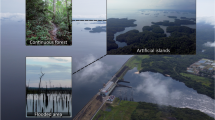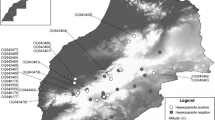Abstract
Plasmodium floridense is a saurian malaria parasite common in the Anolis lizards of the northern Caribbean islands and the SE USA. In the latter area, it is found in two native lizards (Sceloporus undulatus and Anolis carolinensis) and in the introduced Anolis sagrei, which is native to Cuba. We measured parasite prevalence and parasitemia in the introduced anole at a single site in North Port, Florida over 5 years. Prevalence, based on microscopic examination of blood smears, was high year-round (45.6% of adult lizards infected) but was highest in the two December collections and showed significant variation over time. The parasitemia of the P. floridense infections was extremely low, however, with a median of only three parasites per 1,000 red blood cells in infected lizards. This combination of high prevalence and low parasitemia suggests chronic infections for individual lizards and an endemic prevalence pattern. Our study also underscores the need for long-term studies to establish overall prevalence in malarial parasite systems.






Similar content being viewed by others
References
Bromwich CR, Schall JJ (1986) Infection dynamics of Plasmodium mexicanum, a malarial parasite of lizards. Ecology 67:1227–1235
Campbell TS (1996) Northern range expansion of the brown anole (Anolis sagrei) in Florida and Georgia. Herp Rev 27:155–157
Cosgrove CL, Wood MJ, Day KP, Sheldon BC (2008) Seasonal variation in Plasmodium prevalence in a population of blue tits Cyanistes caeruleus. J Anim Ecol 77:540–548
Eisen RJ, DeNardo DF (2000) Life history of a malaria parasite (Plasmodium mexicanum) in its host, the Western fence lizard (Sceloporus occidentalis): host testosterone as a source of seasonal and among-host variation? J Parasitol 86:1041–1045
Garnham PC (1966) Malaria parasites and other haemosporidia. Blackwell Scientific, Oxford
Gerber GP, Echternacht AC (2000) Evidence for asymmetrical intraguild predation between native and introduced Anolis lizards. Oecologia 124:599–607
Goodwin MH (1951) Observations on the natural occurrence of Plasmodium floridense, a saurian malaria parasite in Sceloporus undulatus undulatus. J Nat Malaria Soc 10:57–67
Guerrero S, Pickering J (1984) Malaria survey of Anolis lizards in Puerto Rico. J Parasitol 70:162–164
Jordan HB (1964) Lizard malaria in Georgia. J Protozool 11:562–566
Jordan HB, Friend MB (1971) The occurrence of Schellackia and Plasmodium in two Georgia Lizards. J Protozool 18:485–487
Lee JC (1985) Anolis sagrei in Florida: phenetics of a colonizing species. I. Meristic characters. Copeia 1985:182–194
Lee JC, Clayton D, Eisenstein S, Perez I (1989) The reproductive cycle of Anolis sagrei in Southern Florida. Copeia 1989:930–937
Perkins SL (2000) Species concepts and malaria parasites: detecting a cryptic species of Plasmodium. Proc R Soc London Ser B 267:2345–2350
Perkins SL, Osgood SM, Schall JJ (1998) Use of PCR for detection of subpatent infections of lizard malaria: implications for epizootiology. Mol Ecol 7:1587–1590
Perkins SL, Rothschild AD, Waltari E (2007) Infections of the malaria parasite, Plasmodium floridense, in the invasive Lizard, Anolis sagrei, in Florida. J Herpetol 41:750–754
Saad AH, Khalek NA, Ridi R (1990) Blood testosterone level: a season-dependent factor regulating immune reactivity in lizards. Immunobiology 180:184–194
Schall JJ (1996) Malarial parasites of lizards: diversity and ecology. Adv Parasitol 37:255–333
Schall JJ, Vogt SP (1993) Distribution of malaria in Anolis lizards of Luquillo Forest, Puerto Rico: implications for host community ecology. Biotropica 25:229–235
Schall JJ, Marghoob AB (1995) Prevalence of a malarial parasite over time and space: Plasmodium mexicanum in its vertebrate host, the western fence lizard Sceloporus occidentalis. J Anim Ecol 64:177–185
Schall JJ, Pearson AR, Perkins SL (2000) Prevalence of malaria parasites (Plasmodium floridense and Plasmodium azurophilum) infecting a Puerto Rican lizard (Anolis gundlachi): a nine-year study. J Parasitol 86:511–515
Schoener TW, Spiller DA, Losos JB (2004) Variable ecological effects of hurricanes: the importance of seasonal timing for survival of lizards on Bahamian islands. Proc Natl Acad U S A 101:177–181
Staats CM, Schall JJ (1996a) Distribution and abundance of two malarial parasites of the endemic Anolis lizard of Saba Island, Netherlands Antilles. J Parasitol 82:409–413
Staats CM, Schall JJ (1996b) Malarial parasites (Plasmodium) of Anolis lizards: biogeography in the Lesser Antilles. Biotropica 28:388–393
Thompson P, Huff CG (1944) Saurian malarial parasites of the United States and Mexico. J Infect Dis 74:68–79
Acknowledgments
We thank Jos. J. Schall for helpful comments on this manuscript.
Author information
Authors and Affiliations
Corresponding author
Rights and permissions
About this article
Cite this article
Perkins, S.L., Kerwin, A.S. & Rothschild, A.D. Patterns of infection of the lizard malaria parasite, Plasmodium floridense, in invasive brown anoles (Anolis sagrei) in Southwestern Florida. Parasitol Res 104, 1191–1196 (2009). https://doi.org/10.1007/s00436-008-1310-z
Received:
Accepted:
Published:
Issue Date:
DOI: https://doi.org/10.1007/s00436-008-1310-z




